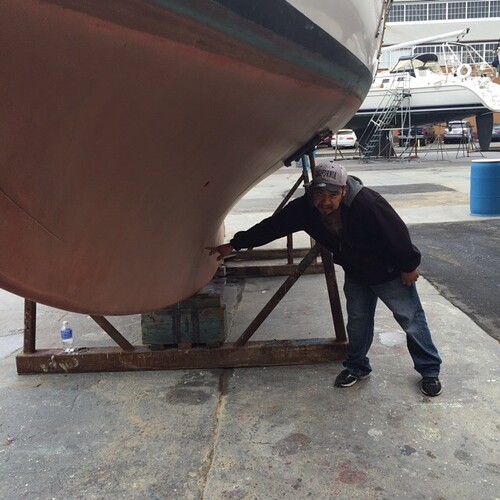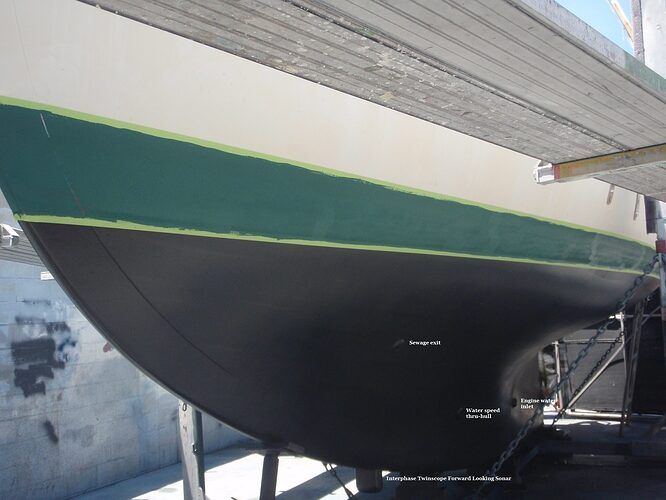I’m in the process of installing all new electronics and transducers. Any thoughts or ideas (pros/cons)regarding plastic verses bronze transducers? Thanks!
Have you considered mounting the transducer inside the hull, no hole? Inside, it doesn’t matter whether it’s a plastic or a bronze transducer. There’s been some discussion on this topic in the past–try using Search?
Dan
There has not been too many discussions on this topic, but here are the feeds:
http://samlmorse.com/forum/search.php?5,search=tranducer,page=1,match_type=ALL,match_dates=0,match_forum=ALL,body=1,author=1,subject=1,category_id=,like_category=
Hi Dan,
I’m replacing my transducers, so my intent is to reuse the existing holes…the challenge is trying to figure out what the best option is between plastic and bronze. I’m leaning towards going with bronze, but I would love to get some feedback to either support or discredit that decision.
I did a search, and of course John was kind enough to supply the feeds in his response. Also, mounting the transducers inside the hull would definitely be worth considering, if the holes didnt already exist!
Thanks for responding!
We installed a flush mounted bronze transducer several years ago. We selected bronze because I simple do not like plastic transducers, thru-hulls, seacock below the waterline. Iduna is all bronze below the waterline, as well as above the waterline.
The cost of a failure below the waterline is not worth the cost savings of plastic component.
If you decide to install a flush mounted transducer and need instructions how to hollow out the mounting space. Let me know.
Rod
BCC IDUNA
Hi Rod,
In speaking with a knowledgeable Marine Services professional I was told plastic is the way to go unless one has a wooden hull, which subjects the plastic to cracking due to the expansion/contraction of the wood.
I also reviewed a couple of YouTube videos and found plastic thru-hulls failed at about half the value of bronze during load testing. Of course you don’t have any electrolysis concerns with plastic, which is a definite plus.
At any rate, I think for peace of mind I’m going to go with bronze to match the rest of my thru-hulls which are all flush mounted bronze. I believe my transducers are flush mounted as well, but if I find out differently I’ll definitely take you up on your offer Rod.
Thanks!
My boat is presently sitting on the hard awaiting the installation of new speed and depth transducers for my new compliment of Raymarine instruments. The old Nexus brand speed transducer (paddle wheel) is mounted slightly forward of my mast on the port side. I’m told the Raymarine speed transducer won’t work in this location as the newer style needs to have a fairing glassed to the hull so the transducer can be positioned appropriately. Can anyone share their knowledge on this subject? I’m also told the same thing goes for my new depth transducer - fairing glassed to hull so the transducer can be pointed straight down.
I’m really having a hard time believing these fairings need to be glassed to my hull for my new transducers to work properly! I am aware the depth transducer can be mounted inside without having to penetrate the hull; however, I prefer to use the same holes that were used for the Nexus transducers.
Any words of wisdom from the BCC community would be greatly appreciated!
I’ve attached a picture showing where my speed transducer penetrates the hull.
The attached photo on my previous post shows the location of my speed transducer.
I’ve not heard of Raymarine transducers needing proprietary fairings, but the company may want better control of installation as a reaction to installations that have not delivered to expectations.
I can understand a fairing for a depth sounder, to ensure that the transducer is perfectly vertical. On an earlier boat, we had the depth transducer internal, sitting in a glycerine-filled box glassed to the inside of the hull. I’ve sailed on boats that have depth transducers sealed to the inside of the hull with various sealants and all have delivered some data.
I less well understand a fairing for a water speed transducer. I’ve seen planing hulls with water speed transducers in bizarre places (e.g. hanging off the transom) but most sail boats have a removable transducer that puts a paddle wheel (or other tech) into smooth laminar flow past the hull.
We fitted Zygote with an Interphase Twinscope Forward Looking Sonar (Interphase is now owned by Garmin, I think) instead of a simple depth transducer. The Interphase FLS transducer came with its own fairing so the transducer is vertical. The fairing and the FLS sit on the keel, 0.735 metres (2.41 ft) in front of the forward face of the mast.
We installed a Raymarine ST60 water speed instrument. The transducer (an Airmar M78716 paddle wheel) penetrates through a bronze thru-hull and of course can be swapped for a dummy that plugs the thru-hull when we’re not sailing. The water speed transducer is outboard and just aft of the mast - we access it by lifting the port access plate (in the cabin sole) beside the mast.
I don’t have a record of measurements with respect to the mast, but the location looks similar to that pointed out in Traveler’s photo. The big difference with Traveler’s earlier Nexus transducer is that Zygote’s transducer is aft of the mast.
The water speed instrument works okay. It interfaces electronically with the rest of the Raymarine nav electronics (i.e. GPS data, wind etc) so the electronic charter can calculate current, leeway etc and feed supposedly sophisticated guidance to the autopilot. I calibrated it against SOG in what I hoped was current-free water and it’s kept me happy.
I couldn’t find a perfect photo (black antifoul makes everything hard to see). With luck you’ll see the port side of the hull, with annotations in white.
Bil

